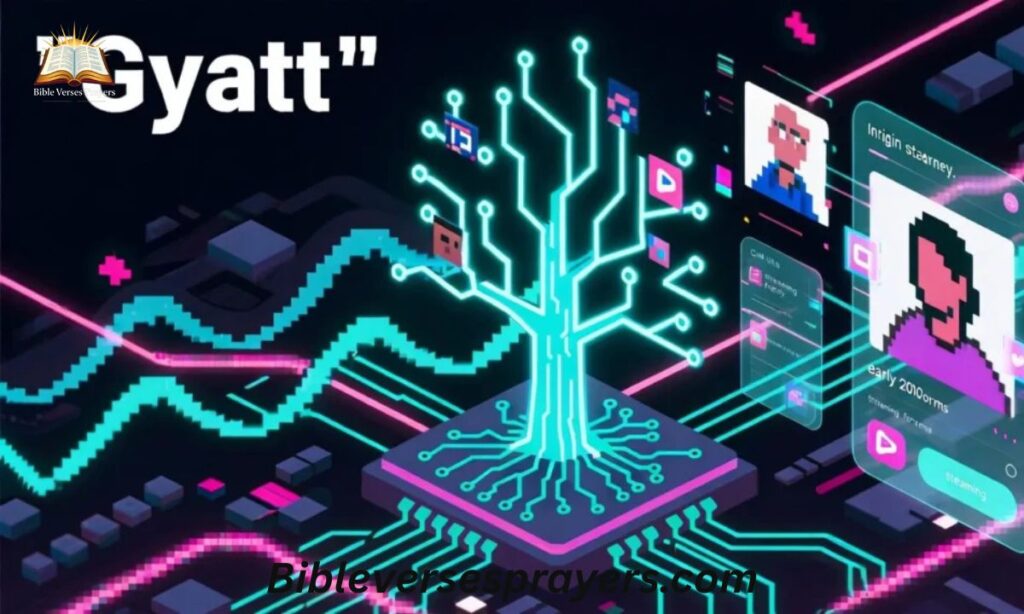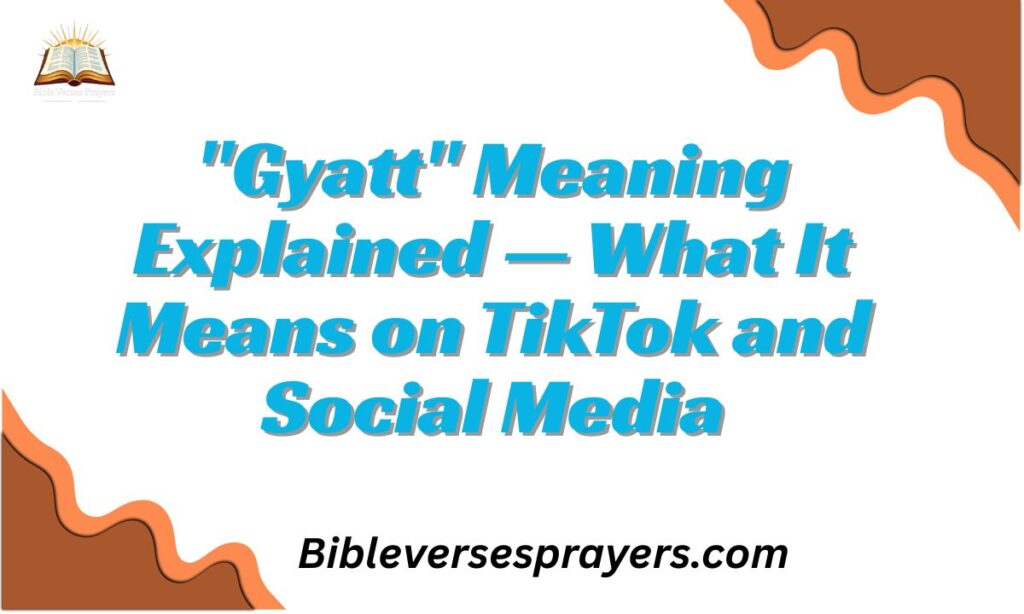Social media platforms constantly create new slang terms. One word that has taken TikTok by storm is “Gyatt.” You’ve probably seen it in comments, captions, and videos. But what does it actually mean? Where did it come from?
Gyatt is an exclamation of excitement or surprise. It’s typically used when someone sees an attractive person. The term is especially popular among Gen Z users. It originated from Twitch streaming culture before spreading to TikTok and other platforms.
Understanding modern slang helps you navigate social media conversations. Gyatt represents how quickly language evolves online today. In this article, we’ll explore the origins, meaning, and usage of Gyatt. We’ll also discuss why it became so popular and how it fits into internet culture.
1. What Does “Gyatt” Mean?
Gyatt is an exclamation expressing admiration or shock. People use it when they see someone physically attractive. It’s similar to saying “wow” or “damn” in reaction to appearance. The term conveys immediate, strong positive reaction to what someone sees.
The Literal Definition
Gyatt is actually a variation of “God damn.” The pronunciation evolved into this shorter, catchier form. It’s an exclamation that expresses strong emotion quickly. The spelling “gyatt” or sometimes “gyat” became the standard online version.
The term specifically relates to physical attraction usually. When someone says “gyatt,” they’re reacting to someone’s appearance. It’s most commonly used about someone with an attractive body. The context almost always involves admiration of physical features.
While the term can be used for anyone, it’s often directed toward women. This has sparked some discussions about objectification and respect. The casual nature of the term raises questions about appropriate online behavior. Understanding context is important when using slang terms.
Different Spellings and Variations
You’ll see several different spellings of gyatt online. “Gyat,” “gyatt,” and “gyyat” all mean the same thing. Some people add extra letters for emphasis or exaggeration. More letters typically indicate stronger reaction or excitement.
The pronunciation remains consistent despite spelling variations. It sounds like “guy-at” when spoken aloud quickly. The spelling doesn’t change the fundamental meaning at all. People choose their preferred spelling based on personal preference.
Some users combine gyatt with other slang terms. “Gyatt damn” is a common extended version. These combinations intensify the expression of surprise or admiration. Social media users love creating variations of popular terms.
How It Differs from Similar Terms
Gyatt is more specific than general exclamations like “wow.” It specifically references physical attraction and appearance. Terms like “sheesh” express excitement but aren’t appearance-focused. Gyatt has a distinct meaning within internet slang vocabulary.
Compared to older slang like “damn” or “hot damn,” gyatt is more casual. It fits the fast-paced, shortened nature of social media communication. Younger generations prefer these evolved, internet-native terms. They feel more authentic to digital culture than traditional expressions.
Gyatt also carries a playful, less serious tone than direct compliments. It’s used more casually in comment sections and videos. The term exists in a specific social media context. Understanding this context helps with appropriate usage and interpretation.
2. The Origin of “Gyatt”

Every slang term has an origin story worth exploring. Gyatt’s journey from streaming platforms to mainstream TikTok is fascinating. Understanding where it came from helps explain why it became so popular.
Birth on Twitch Streaming Platform
Gyatt originated from Twitch streamer Kai Cenat around 2021. He would exclaim the phrase during his live streams frequently. His energetic, spontaneous reactions made the term memorable. Viewers started adopting it and using it in chats.
Kai Cenat’s streaming style is known for high energy. He reacts dramatically to content and situations during streams. His use of “gyatt” fit perfectly with his personality. The term became associated with his brand and content style.
Twitch chat culture spreads terms rapidly among viewers. When streamers use phrases repeatedly, fans pick them up. They use them in other chats and on other platforms. This is how internet slang typically spreads from source to mainstream.
Migration to TikTok
TikTok users discovered gyatt through clips from Kai Cenat’s streams. Short video format helped the term spread even faster. Users started incorporating it into their own TikTok videos. The algorithm amplified content using the trending term.
By 2022 and 2023, gyatt had become a TikTok staple. Comment sections were filled with the term on certain videos. Creators started using it intentionally to boost engagement. The term became part of Gen Z’s digital vocabulary quickly.
TikTok’s format is perfect for spreading catchphrases like gyatt. Short videos with quick reactions match the term’s energy. Users could easily incorporate it into various content types. This versatility helped it gain widespread adoption and usage.
Mainstream Recognition
By 2023, gyatt had reached mainstream awareness beyond social media. News outlets started explaining Gen Z slang including gyatt. Parents and teachers began asking about the term’s meaning. This indicates the term achieved significant cultural penetration outside its origin.
The term appeared in YouTube videos, Instagram posts, and Twitter. It crossed platform boundaries successfully unlike some slang. This cross-platform presence solidified its place in internet culture. Gyatt became recognizable even to people not actively using it.
Some dictionaries and slang databases added gyatt to their entries. This formal recognition marks a term’s transition from niche to established. However, internet slang evolves so quickly that mainstream recognition often comes late. By the time dictionaries add terms, they’re sometimes already declining in use.
| Platform | Role in Gyatt’s Spread | Time Period |
| Twitch | Original source (Kai Cenat) | 2021 |
| TikTok | Mass popularization | 2022-2023 |
| YouTube | Secondary spread through clips | 2022-2023 |
| Cross-platform adoption | 2023 | |
| Twitter/X | Meme culture integration | 2023-2024 |
3. How “Gyatt” Is Used on Social Media
Understanding how to use gyatt properly requires observing social media contexts. The term appears in various situations across different platforms. Each context carries slightly different implications and appropriateness levels.
In TikTok Comments
TikTok comments are where gyatt appears most frequently. Users comment “gyatt” on videos featuring attractive people. It’s a quick reaction that expresses admiration without lengthy compliments. The term fits TikTok’s fast-paced, short-form communication style perfectly.
Often you’ll see multiple “gyatt” comments on the same video. This creates a collective reaction from viewers simultaneously. The repetition reinforces the sentiment across the comment section. It becomes almost a ritual response to certain types of content.
Some creators intentionally create content to generate “gyatt” reactions. They know certain poses, outfits, or angles will trigger responses. This understanding shapes content creation strategies on the platform. The term has become part of TikTok’s engagement ecosystem.
In Video Captions and Voiceovers
Creators incorporate gyatt into their video captions strategically. Using trending slang helps videos appear in search results. It signals that content is current and culturally relevant. This can boost a video’s visibility and reach significantly.
Some videos feature the spoken word “gyatt” in voiceovers. Creators react to themselves or others with the exclamation. This adds energy and relatability to the content produced. It connects with viewers through shared linguistic understanding and culture.
Reaction videos often use gyatt as a recurring element. The dramatic delivery matches reaction video formats perfectly. It provides punctuation to visual moments of surprise or admiration. This usage has become a recognizable content pattern on TikTok.
In Memes and Viral Content
Gyatt has been incorporated into countless memes and jokes. People create humorous content exaggerating the term’s usage. Some memes mock overly enthusiastic use of the term. Others celebrate it as part of Gen Z culture identity.
Image macros and text posts feature gyatt regularly now. The term appears in relatable content about online behavior. It’s used both ironically and sincerely in different contexts. This flexibility makes it useful for various comedic purposes.
The term has become shorthand for Gen Z internet culture. Using it signals membership in a particular online community. Older generations using it often comes across as trying too hard. This generational marker aspect is common with internet slang evolution.
Cross-Platform Usage
While TikTok remains gyatt’s primary home, it’s spread elsewhere. Instagram Reels feature the term in similar contexts as TikTok. YouTube Shorts creators have adopted it into their vocabulary. The term transcends individual platforms while maintaining consistent meaning.
Twitter users incorporate gyatt into text-based posts and replies. The written form works just as well as spoken versions. Discord servers and group chats use it in casual conversations. This shows the term’s versatility across communication formats and styles.
Even platforms like Reddit discuss and use gyatt occasionally. Though Reddit skews older demographically, the term still appears. This broad platform adoption indicates strong cultural staying power. Terms that cross platform boundaries tend to last longer overall.
4. Why “Gyatt” Became So Popular

The explosive popularity of gyatt isn’t random or accidental. Several factors combined to make it a viral sensation. Understanding these factors reveals how internet culture operates and evolves.
The Influence of Kai Cenat
Kai Cenat’s massive following gave gyatt initial momentum immediately. With millions of followers, his phrases reach vast audiences. When he uses a term consistently, fans adopt it naturally. His influence on Gen Z culture cannot be overstated or ignored.
His authentic, energetic personality made the term feel genuine. It wasn’t forced or manufactured for marketing purposes. Organic adoption is much more powerful than manufactured slang. Viewers felt they were part of his community by using his phrases.
Kai Cenat represents a new generation of influencers shaping language. Streamers and content creators now influence language like celebrities once did. Their direct connection with audiences creates stronger linguistic impact. This represents a shift in how slang develops and spreads.
Catchiness and Simplicity
Gyatt is extremely easy to say and remember quickly. One syllable words spread faster than complex phrases typically. The sound is distinctive and attention-grabbing when spoken aloud. These qualities make it ideal for viral adoption across platforms.
The term requires no explanation in context usually. When someone says “gyatt,” the meaning is immediately clear. This accessibility lowers the barrier to adoption significantly. New users can start using it without extensive cultural knowledge.
The playful sound makes it fun to say repeatedly. People enjoy using words that feel good phonetically. This encourages repeated use which reinforces popularity further. The term has inherent qualities that promote its own spread.
Relatability and Expression
Gyatt fills a linguistic need for quick, emphatic reactions. Social media moves fast and demands efficient communication. A single word conveys what a sentence might have previously. This efficiency is valuable in comment sections and fast-paced conversations.
The term allows people to express attraction without vulnerability. It’s more casual than a direct, serious compliment. This emotional distance makes it comfortable for many users. People can participate in social interactions with less perceived risk.
Everyone experiences moments of surprise at physical appearance sometimes. Gyatt provides a socially acceptable way to express these reactions. It normalizes responses that might otherwise seem inappropriate to voice. This makes it highly relatable across user demographics and backgrounds.
Algorithm and Trend Amplification
Social media algorithms reward engagement and trending content actively. Videos using popular terms get boosted in recommendations. This creates a positive feedback loop for viral slang. The more people use gyatt, the more it spreads automatically.
TikTok’s For You Page particularly amplifies trending audio and terms. Once gyatt reached critical mass, the algorithm did the rest. Users encountered it constantly in their feeds and recommendations. This repeated exposure normalized the term incredibly quickly across the platform.
Content creators strategically use trending terms for visibility purposes. Including gyatt in videos helps them reach larger audiences. This practical benefit encourages widespread adoption beyond genuine usage. The algorithm essentially incentivizes using viral slang terms consistently.
5. Controversies and Criticism Around “Gyatt”
Like many internet phenomena, gyatt has faced criticism and controversy. Not everyone appreciates the term or its usage patterns. Understanding these criticisms provides a balanced perspective on internet slang culture.
Objectification Concerns
Critics argue that gyatt reduces people to their physical appearance. The term focuses exclusively on body and attractiveness judgments. This can feel objectifying and disrespectful to many people. The casualness of the term might normalize inappropriate commentary.
Women particularly face excessive “gyatt” comments on their content. Even videos with no romantic or sexual intent get these reactions. This can make content creation uncomfortable for some creators. The volume of such comments can feel overwhelming and invasive.
Some argue the term is harmless appreciation and compliment. Context and intention matter in determining appropriateness they say. The debate reflects larger conversations about online behavior standards. There’s no universal agreement on where the line should be drawn.
Generational Divide
Older generations often find gyatt confusing or inappropriate completely. They don’t understand the context or cultural significance behind it. This creates communication barriers between age groups using social media. Parents worry about the language their children use online regularly.
Some older users attempting to use gyatt come across as inauthentic. There’s a perception that certain slang belongs to specific generations. When outsiders adopt it, it can feel like cultural appropriation. This generational gatekeeping is common with youth slang throughout history.
However, language naturally evolves and crosses generational boundaries over time. Today’s youth slang often becomes tomorrow’s mainstream vocabulary. The discomfort older generations feel is a recurring historical pattern. Every generation has terms that confused or concerned their elders initially.
Overuse and Saturation
As with any viral term, gyatt has faced overuse fatigue. Comment sections filled with repetitive “gyatt” can become annoying. The term loses impact when used excessively without variety. Some users have begun mocking its overuse through satire.
Overuse can make a term feel stale or outdated quickly. Internet culture moves fast and demands constant novelty and freshness. What’s trendy today might be cringe tomorrow suddenly. Gyatt may already be declining in some circles due to saturation.
Some creators have moved away from using it intentionally now. They seek to differentiate themselves from mainstream trends constantly. This cycle of adoption and abandonment is typical in internet culture. New terms are already emerging to potentially replace gyatt eventually.
Appropriateness in Different Contexts
Using gyatt in professional or formal settings is generally inappropriate. The casual, appearance-focused nature doesn’t fit all environments or situations. Young people need to understand code-switching between contexts appropriately. Internet slang and professional communication require different vocabularies entirely.
Educational settings have seen conflicts over the term’s usage. Teachers may not understand or appreciate students using gyatt. This can create disciplinary situations based on miscommunication completely. Clear guidelines about appropriate language help prevent these conflicts.
The term’s appropriateness also depends on relationship and consent. Commenting “gyatt” on a friend’s post differs from a stranger’s. Understanding social boundaries online is crucial for respectful interaction. Not everyone welcomes unsolicited comments about their physical appearance ever.
6. The Future of “Gyatt” and Internet Slang

Predicting the longevity of internet slang is challenging but fascinating. Will gyatt remain popular or fade into obscurity? Understanding slang evolution patterns helps us make educated guesses about its future.
Staying Power or Fading Trend?
Some internet slang terms achieve lasting status in vocabulary. Words like “selfie” and “meme” have become dictionary-standard terms. Others like “on fleek” or “YOLO” fade relatively quickly. Gyatt’s future depends on continued use and cultural relevance over time.
Currently, gyatt shows signs of declining in some communities already. The peak popularity may have passed in early trendsetter groups. However, it’s still spreading to newer users and younger audiences. This staggered adoption can extend a term’s lifespan significantly overall.
The term may evolve into something different entirely eventually. Language is constantly changing and adapting to new contexts. Gyatt could morph into variations with slightly different meanings. This evolution would represent natural linguistic development and progression.
Impact on Digital Communication
Gyatt represents broader trends in how we communicate online. Single-word expressions replace longer, more detailed responses increasingly. Efficiency and speed prioritize over nuance and depth regularly. This shift affects how we express complex emotions digitally.
The visual nature of modern social media demands quick reactions. Text comments must compete with images and videos for attention. Short, punchy terms like gyatt perform better in this environment. This reality shapes language evolution toward brevity and impact consistently.
Emotive expressions increasingly replace descriptive language in digital spaces. Rather than explaining why something is attractive, we just say “gyatt.” This reflects both efficiency and a shared cultural understanding. Context does more communicative work than the words themselves sometimes.
The Cycle of Internet Slang
Internet slang follows predictable patterns from emergence to decline. Early adopters discover and popularize terms within niche communities. Mainstream adoption follows as the term spreads to larger platforms. Eventually overuse leads to decline and replacement by new terms.
Gyatt has already progressed through several stages of this cycle. It emerged from Twitch, spread to TikTok mainstream, and faced saturation. The next stage typically involves ironic use and eventual abandonment. New terms are constantly emerging to fill the void left behind.
This rapid turnover is accelerating with social media’s speed. Terms that might have lasted years now peak in months. The next “gyatt” is probably already circulating in niche communities. Staying current requires constant attention to evolving digital culture and trends.
Linguistic and Cultural Significance
Despite its potential ephemerality, gyatt tells us something important. It demonstrates how digital platforms are actively creating new language. The internet isn’t just using language—it’s generating it at unprecedented rates. This makes our era unique in linguistic history and development.
Terms like gyatt also reflect generational identity and cohesion. Using specific slang creates in-group bonding among users. It distinguishes digital natives from older generations clearly and immediately. This social function is as important as the literal meaning.
Researchers study terms like gyatt to understand cultural shifts. Language evolution reveals changing values, behaviors, and social norms. How we talk about attraction online reflects broader cultural attitudes. Internet slang serves as a cultural artifact worth preserving and studying.
Final Thoughts
Gyatt has become a defining term of Gen Z internet culture. It originated from streaming culture and exploded on TikTok successfully. The term represents how quickly language evolves in digital spaces. Its popularity shows the power of influencer culture and platform algorithms.
While gyatt faces criticism for objectification concerns, it remains widely used. Like all slang, it serves social and communicative functions beyond literal meaning. It creates community, expresses emotion quickly, and marks generational identity clearly. These functions ensure its significance regardless of longevity overall.






